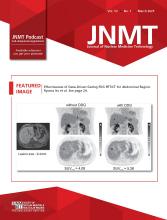Abstract
The purpose of this research is to evaluate the necessity of using heparin in UltraTag™ RBC kits used for nuclear medicine studies. Methods: Non-heparinized blood (n = 15) and heparinized blood (n = 15) were added into UltraTag™ RBC kits. The samples were evaluated for macroscopic blood clots and microscopic platelet clumping. Control groups with heparin (n = 15) and control groups without heparin (n = 15) were used to help evaluate the effectiveness of the anticoagulant properties within the UltraTag™ RBC kits (sodium citrate) and to evaluate if that played a role in preventing blood clots/clumps. To detect macroscopic clotting the wooden applicator stick method was used. To detect microscopic platelet clumping blood smears were evaluated using a light microscope. The number of macroscopic clots and microscopic platelet clumping were compared between the two individual samples. Fisher’s Exact Test was used to evaluate the significance of the data. Results: Macroscopically for the UltraTag™ RBC kits, two of fifteen UltraTag™ RBC Non-heparinized vials clotted and zero of fifteen UltraTag™ RBC Heparin vials clotted. Macroscopically for the control group two of fifteen Control Non-heparinized tubes clotted and zero of fifteen Control Heparin tubes clotted. Microscopically for the Ultra-Tag™ RBC kits three of the fifteen UltraTag™ RBC Non-heparinized vials clumped and three of the fifteen UltraTag™ RBC Heparin vials clumped. Microscopically for the control group fifteen of fifteen Control Non-heparinized tubes clumped and ten of the fifteen Control Heparin tubes clumped. Conclusion: When heparin isn’t used, Ultra-Tag™ RBC kits are more likely to form macroscopic clots. Heparin should always be used when making an Ultra-Tag™ RBC kit for nuclear medicine studies.







